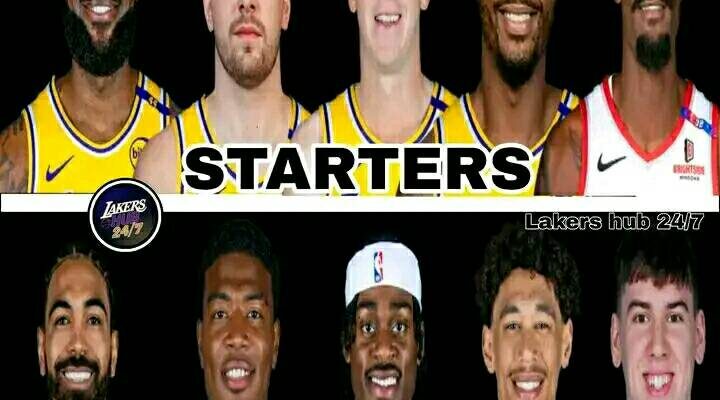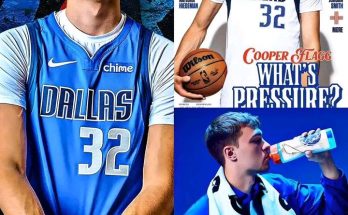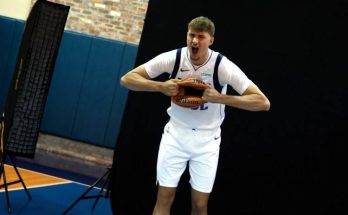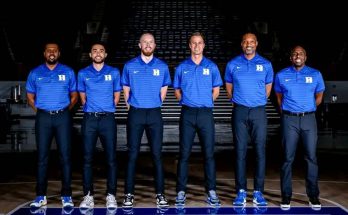The Los Angeles Lakers always find themselves at the center of NBA speculation, and this offseason is no different. With LeBron James opting into his \$52.6 million player option for the 2025–26 season, the franchise is committed to making another championship push around its superstar core. But to do so, depth, balance, and proper rotation management will be critical. According to Jovan Buha, who has been closely monitoring the Lakers’ roster construction, a projected 10-man rotation has emerged that provides insight into how head coach JJ Redick might distribute minutes among his players. This projected breakdown is less about star power alone and more about creating lineups that maximize strengths, minimize weaknesses, and put the Lakers in position to thrive over the course of an 82-game grind and into the postseason.
The most important aspect of this rotation begins with LeBron James. Entering his 23rd NBA season, James is still playing at an elite level, but age and mileage demand careful workload management. Buha’s projection has LeBron playing around 32–34 minutes per game. This reflects a balance between keeping him fresh and still allowing him to orchestrate the offense as the team’s primary initiator. At this stage, James is more likely to pick his spots, conserving energy for big stretches late in games and, more importantly, for the playoffs. His minutes at both forward positions give the Lakers the flexibility to go big with Anthony Davis alongside another big man, or small with LeBron functioning as a point forward surrounded by shooters.
Speaking of Davis, the franchise centerpiece and defensive anchor is also slotted into the 34–36 minute range. Davis continues to be one of the league’s most versatile defenders, capable of protecting the rim while switching onto guards. Offensively, he remains a high-level scorer who can operate in the post, face up, and finish in transition. What makes Davis so important in this rotation is not just his ability to play heavy minutes but also his willingness to slide between power forward and center depending on matchups. This flexibility allows the Lakers to alternate between jumbo lineups that overwhelm opponents physically and more modern, spaced-out lineups that rely on Davis’ mobility at the five.
Around those two stars, the Lakers’ rotation takes shape with D’Angelo Russell, Austin Reaves, Rui Hachimura, Jarred Vanderbilt, and newly added depth pieces forming the supporting cast. Russell, who opted to stay in Los Angeles after rediscovering confidence last season, is projected for around 30–32 minutes per game. His offensive production and shot creation remain vital for a Lakers team that often struggled with half-court scoring. Russell’s ability to handle point guard duties takes pressure off LeBron, but his defensive shortcomings mean the Lakers may stagger his minutes depending on matchups. Still, his playmaking and shooting keep him in the high-minute range of Buha’s projection.
Austin Reaves is penciled in for 28–32 minutes, a reflection of his two-way reliability. Reaves has blossomed into a trusted starter, capable of spacing the floor with his shooting while also defending multiple positions. His basketball IQ and chemistry with both LeBron and Davis ensure he will continue to play major minutes. More importantly, Reaves can serve as a secondary ballhandler, which gives the Lakers lineup versatility when Russell or LeBron rest. Reaves’ steadiness makes him one of the safest rotation locks.
Rui Hachimura, meanwhile, is projected for about 26–28 minutes, with the potential for more in games where his scoring punch is needed. Hachimura has established himself as a strong mid-range scorer and transition threat. While his defense can be inconsistent, his size and length give the Lakers another forward option who can slot in alongside either LeBron or Davis. His ability to stretch the floor from the corners also fits well in lineups where spacing is crucial. Buha’s breakdown sees Hachimura playing both with starters and second units, serving as a bridge between lineups.
Jarred Vanderbilt is projected for 18–22 minutes, primarily as a defensive specialist. His on-ball defense and energy make him a valuable rotation piece, particularly against elite wings and perimeter scorers. However, his limited offensive game caps his overall minutes. In matchups where defense and rebounding are paramount, Vanderbilt could see extended time. Conversely, against teams that force the Lakers into offensive shootouts, his role might shrink. That variance is built into Buha’s projection, which reflects Vanderbilt’s situational utility.
One of the biggest questions is how much playing time Gabe Vincent, the free-agent guard brought in last offseason, will receive. Buha projects Vincent at 20–24 minutes per game, largely as the stabilizer for bench units. Vincent’s toughness, perimeter defense, and spot-up shooting make him a strong fit for a Lakers team that needed more reliability in its guard rotation. His playoff experience with the Miami Heat also adds to his value. If Russell or Reaves falter, Vincent could easily see his role expand into starter-level minutes.
On the wing, the Lakers are expected to give Cam Reddish 16–20 minutes per game. Reddish has always been seen as a high-upside player with physical tools that scream potential, but consistency has been the missing piece. For the Lakers, his length and ability to defend multiple positions make him worth developing in a rotation role. If he can provide reliable three-point shooting and defensive engagement, his minutes could rise quickly. However, Buha’s projection remains conservative, reflecting the uncertainty around his night-to-night impact.
Jaxson Hayes, the athletic big man, is slotted for 14–16 minutes as Davis’ primary backup at center. Hayes’ rim-running, shot-blocking, and energy provide a nice change of pace. He is unlikely to play in high-leverage situations but gives the Lakers depth at a position they’ve often lacked behind Davis. In certain matchups, Hayes could be paired with Davis in twin-tower lineups, but his offensive limitations keep him in a smaller minute role overall.
Finally, rookie Dalton Knecht is projected for 12–15 minutes per game. As a first-year player, Knecht will have to earn his time, but his reputation as a scorer and shooter makes him intriguing. The Lakers have long needed more reliable floor spacing, and Knecht could carve out a role if he adjusts quickly to the NBA level. His minutes will likely fluctuate throughout the season depending on his defensive growth and shooting consistency, but Buha’s projection suggests he will be given opportunities to contribute early.
When combining all these pieces, the Lakers’ projected 10-man rotation has a clear balance. LeBron and Davis remain the cornerstones, each carrying over 30 minutes but not overextended to the point of risking injury or fatigue. Russell and Reaves round out the starting backcourt with heavy minutes, while Hachimura offers scoring punch as the fifth starter. Vanderbilt, Vincent, Reddish, Hayes, and Knecht make up the core bench unit, each with roles designed to complement the stars. The minute distribution reflects an emphasis on preserving health while maintaining competitiveness.
The key takeaway from this projection is that the Lakers are finally embracing depth in a way they have not consistently done in the LeBron era. Too often, the team leaned heavily on James and Davis while surrounding them with minimum-level players. Buha’s breakdown suggests a more balanced approach where secondary and tertiary contributors have defined roles and playing time. This is essential for an aging superstar like LeBron and for a team that has championship aspirations but also has to navigate the unpredictability of an NBA season.
There will, of course, be fluidity. Injuries, matchups, and performance fluctuations will all dictate changes in minute distribution. If Reddish struggles, Knecht may see more time. If Davis misses games, Hayes’ minutes will spike. If Russell’s defensive issues resurface, Vincent could become a more prominent figure. The projected rotation is not a rigid plan but rather a roadmap for how the Lakers intend to manage talent and maximize their chances of winning.
For the Lakers’ front office and coaching staff, the ability to balance stars with role players will determine how far this team can go. Redick, in his first year as a head coach, will be tasked with finding combinations that work and being flexible enough to adjust as the season unfolds. Buha’s projection provides a blueprint, but it will be up to the Lakers to bring it to life on the court. The franchise has built a rotation that, at least on paper, has depth, versatility, and the potential to contend. Now the question is whether the pieces can stay healthy, perform consistently, and rise to the moment when the playoffs arrive.
In the end, this projected 10-man rotation is not just a list of names and minutes but a reflection of the Lakers’ strategy for the upcoming season. It is about maximizing LeBron’s final years, keeping Davis engaged and healthy, and building a supporting cast that can elevate the team when it matters most. If the rotation plays out as envisioned, the Lakers will have a legitimate chance to contend in the West. If not, questions will once again surface about whether the team built around its stars in the right way. For now, the Lakers enter the season with clarity on how their rotation might look, and that gives them a foundation to build upon as they chase another championship.



